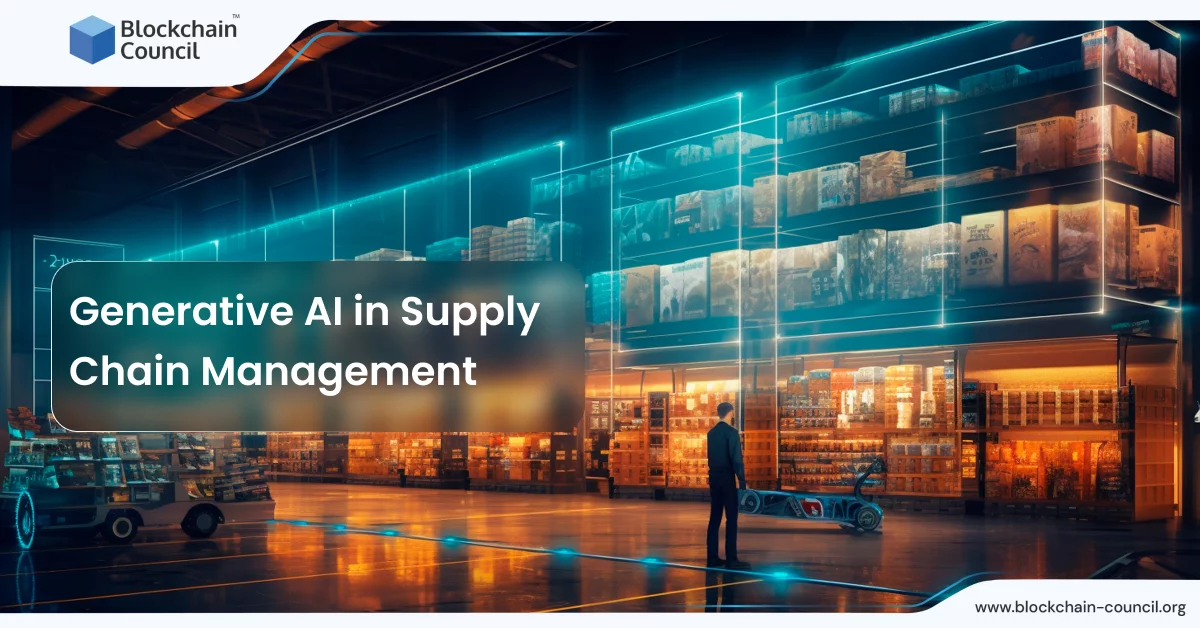
- Blockchain Council
- September 13, 2024
Summary
- Generative AI is a transformative force in supply chain management, reshaping industries by creating new, original content from existing data.
- It utilizes deep learning and neural networks, emphasizing unsupervised learning to generate diverse and creative outputs.
- In supply chain management, Generative AI plays a crucial role in demand forecasting, route optimization, inventory management, and supplier selection.
- It enhances communication within the supply chain through human-like responses, reduces downtime with predictive maintenance, and identifies risks for proactive mitigation.
- Generative AI optimizes logistics by streamlining last-mile delivery, predicting maintenance needs, and providing real-time tracking for better coordination.
- Case studies of Amazon and DHL highlight the practical applications and success of Generative AI in optimizing delivery networks and route planning.
- In inventory management, Generative AI improves accuracy in demand forecasting, minimizes overstocking and stockouts, and adapts to changing market dynamics.
- The technology contributes to risk management by identifying disruptions, assessing risks, and generating contingency plans based on data-driven insights.
- Generative AI plays a significant role in supplier relationship management, aiding in supplier selection, negotiation optimization, and promoting collaboration.
- In sustainability, Generative AI supports eco-friendly practices in sourcing, packaging, and transportation, contributing to reduced environmental impact and operational costs.
Introduction
In today’s rapidly evolving landscape, technology is reshaping industries, and supply chain management is no exception. Generative AI, an entire branch of artificial intelligence. AI has come up as a game-changer in various sectors. Generative AI creates new, original content from existing data. It’s not confined to rule-based tasks; it generates diverse and creative outputs. Art to language, it’s transforming how we innovate and problem-solve. Deep learning and neural networks have fueled Generative AI advancements.
Supply chain management is the backbone of businesses, ensuring smooth operations and customer satisfaction. Efficient supply chains reduce costs, improve delivery times, and optimize resources. Timely product availability enhances customer trust and loyalty. Effective supply chain management leads to a strategic market advantage. It handles intricate processes, from raw materials to end products.
Fundamentals of Generative AI
Generative AI creates data that imitates real-world patterns, driving innovation in supply chains. Generates new data instances that resemble existing patterns, aiding decision-making. Generates content like images, music, text, pushing boundaries of creativity. Employs GANs and VAEs to simulate and create diverse data samples. Focuses on creating new content, distinct from traditional AI’s problem-solving. Emphasizes unsupervised learning, learning from unlabeled data for creativity. Enables machines to mimic human-like creative processes and produce content.
-
Applications of Generative AI in Various Industries
Generates unique art pieces, designs, and creative elements. Designs molecular structures and aids drug discovery. Creates virtual worlds, characters, enhancing gaming experiences. Generates financial models, simulations, and risk assessment tools. Designs new clothing styles, patterns, and fashion trends. Content Generation like, Produces articles, scripts, and marketing content. Creates synthetic medical images, aids diagnosis and training. Optimizes product designs, prototypes, and production processes.
Also Read: How Blockchain and AI Can Work Together
Generative AI in Supply Chain Management: An Overview
| Role of Generative AI | Description |
| Demand Forecasting | Utilizes historical data and market trends to predict future demand, helping optimize inventory levels and minimize stock outs or overstock. |
| Route Optimization | Generates efficient delivery routes, considering factors like traffic, weather, and delivery windows, to reduce transportation costs and delivery time. |
| Inventory Management | Recommends reorder points, safety stock levels, and optimal storage locations to streamline inventory handling and reduce carrying costs. |
| Supplier Selection | Assists in selecting reliable suppliers by analyzing their performance data, pricing, and delivery history, enhancing supply chain reliability. |
| Natural Language Communication | Enhances communication within the supply chain by generating human-like responses to inquiries, reducing response times and improving customer satisfaction. |
| Predictive Maintenance | Predicts equipment failures and maintenance needs in real-time, reducing downtime and ensuring the smooth flow of goods. |
| Risk Assessment | Identifies potential disruptions and risks in the supply chain, such as natural disasters or geopolitical events, and recommends mitigation strategies. |
| Quality Control | Monitors product quality through image analysis and other sensors, ensuring that only high-quality goods enter the supply chain. |
| Energy Efficiency | Optimizes energy usage in warehouses and transportation, reducing costs and environmental impact. |
| Customization | Generates tailored solutions for specific logistics challenges, adapting to unique supply chain requirements. |
Role of Generative AI in Logistics
-
Optimizing Routes and Fleet Management
Generative AI optimizes delivery routes for reduced transit time and fuel consumption. Fleet management becomes data-driven, enhancing operational efficiency and cost-effectiveness. Real-time traffic updates enable smart rerouting and avoidance of congested areas. Generative AI enables real-time tracking of shipments and inventory across the supply chain. Enhanced visibility ensures better coordination, minimizing delays and improving customer satisfaction. Instant alerts empower proactive issue resolution and risk management.
-
Streamlining Last-Mile Delivery & Predictive Maintenance for Vehicles
Last-mile delivery complexities are simplified through AI-driven route optimization. AI algorithms consider variables like package size, delivery windows, and location for precision. Efficient last-mile delivery reduces costs and accelerates order fulfillment. Generative AI predicts vehicle maintenance needs, reducing breakdowns and downtime. Sensors and data analysis enable timely servicing and part replacements. Improved vehicle reliability maintains seamless supply chain operations.
-
Demand-Driven Inventory Management & Collaborative Supplier Management
Generative AI analyzes historical data and market trends for accurate demand forecasting. Inventory levels are adjusted based on demand fluctuations, preventing stockouts and overstocking. Efficient inventory management maximizes capital utilization and minimizes waste. AI facilitates supplier collaboration through automated communication and order processing. Supplier performance is assessed using data-driven metrics, enhancing decision-making. Negotiation and procurement processes are optimized for mutual benefits.
In the realm of supply chain logistics, Generative AI showcases its transformative potential through real-life success stories.
Case Study 1:
Amazon, a pioneer in logistics, employs Generative AI to optimize its vast delivery network. By analyzing data on package size, destination, and real-time traffic conditions, the AI system dynamically reroutes delivery vehicles. Resultantly, delivery times are reduced, operational costs are minimized, and customer satisfaction soars.
Case Study 2:
DHL, a leader in express logistics, leverages Generative AI for route planning. By amalgamating historical delivery data, weather forecasts, and traffic patterns, the AI system devises optimal delivery routes. This results in quicker deliveries, reduced fuel consumption, and lower carbon emissions, showcasing DHL’s commitment to sustainability.
Also Read: Generative AI in Real Estate
Inventory Management and Demand Forecasting
| Aspect | Inventory Management | Demand Forecasting with Generative AI |
| Definition | Overseeing and controlling storage, ordering, and usage of inventory | Predicting future demand using generative AI models |
| Objective | Minimize carrying costs, prevent stockouts, ensure efficient supply | Enhance accuracy in demand forecasting, optimize inventory levels |
| Key Challenges | Overstocking, stockouts, obsolescence, inadequate forecasting | Data quality, model complexity, adapting to changing market |
| Traditional Methods | EOQ, JIT, ABC analysis, reorder point methods | Time series analysis, regression, statistical modeling |
| Generative AI Application | Analyzing historical sales data, optimizing inventory strategies | Using neural networks to simulate and forecast demand patterns |
| Benefits of Generative AI | Enhanced accuracy, reduced overstocking and stockouts | Improved forecasting precision, automation of forecasting |
| Future Trends | Integration of AI-powered sensors, IoT for real-time monitoring | Advancements in generative AI for handling complex dynamics |
Risk Management and Mitigation
-
Identifying Potential Disruptions
AI processes vast data to pinpoint early signs of potential disruptions. Identifies trends and anomalies, foreseeing disruptions before they escalate. Monitors external factors affecting supply chains, aiding proactive measures. Generative AI optimizes resource allocation to prevent shortages or excesses. It considers geopolitical, environmental, and regulatory factors for proactive insights. Generative AI processes real-time demand data, highlighting sudden changes.
-
Supply Chain Risk Assessment
Generative AI reviews historical data, supplier information, and market dynamics. It assigns risk scores, enabling prioritization and allocation of resources. AI models simulate various risk scenarios to gauge potential impacts. Traditional risk assessment methods often rely on periodic evaluations, which may lead to delayed responses to emerging threats. It identifies anomalies, trends, and patterns that might indicate impending disruptions, allowing supply chain managers to take immediate corrective actions. One of the most powerful aspects of Generative AI is its ability to learn and adapt over time. As new data becomes available and the supply chain environment evolves, AI models can refine their risk assessments and recommendations. This continuous learning loop ensures that risk assessments remain accurate and up-to-date.
-
Contingency Planning with Generative AI
AI generates multiple contingency plans based on data-driven insights. It suggests efficient allocation of resources, minimizing downtime and losses. Plans evolve as new data emerges, ensuring adaptability in dynamic situations. The inherent complexity of supply chains demands a streamlined approach to contingency planning. Generative AI distills multifaceted data into actionable blueprints, offering simplified yet nuanced strategies that resonate across the organizational spectrum. In an ever-evolving supply chain landscape, adaptability is the bedrock of resilience. Generative AI continually recalibrates contingency plans, infused with real-time data, ensuring that responses align with the current state of affairs.
Also Read: Top 5 Generative AI Models to Watch Out For in 2024
Supplier Relationship Management
In the world of supply chain management, Supplier Relationship Management (SRM) takes center stage. SRM involves cultivating and maintaining robust partnerships with suppliers to ensure a seamless flow of goods and services.
-
Supplier Selection and Evaluation
Generative AI aids in identifying the most suitable suppliers based on data-driven insights. Evaluate suppliers’ performance objectively using AI-generated metrics and KPIs. Predict and mitigate potential supplier risks through AI-powered risk analysis models. AI-enabled tools offer real-time monitoring of supplier performance for proactive decision-making.
-
Negotiation Optimization
AI-driven insights inform negotiation strategies, optimizing terms and pricing. Generative AI provides up-to-date market trends for informed negotiations. AI-powered tools streamline contract review, ensuring favorable terms and compliance. Data-driven negotiations result in mutually beneficial agreements for both parties.
-
Collaboration and Communication
AI facilitates seamless communication and information sharing between suppliers and stakeholders. AI-generated forecasts help suppliers align production with actual demand, minimizing disruptions. Real-time tracking and transparency enable better collaboration and issue resolution. AI-enabled feedback mechanisms promote continuous improvement and innovation.
Incorporating Generative AI in supplier relationship management streamlines processes, propelling supply chains forward.
Also Read: Top 5 Certifications and Courses To Learn About Generative AI
Sustainability and Green Supply Chain
| Aspect | Sustainability in Supply Chain | Green Supply Chain with Generative AI |
| Definition | Reducing environmental impact, ethical sourcing, social responsibility | Using Generative AI to optimize supply chain, focus on reducing environmental footprint |
| Key Objectives | Minimize carbon emissions, promote fair labor practices, reduce energy consumption | Enhance demand forecasting, optimize transportation routes, encourage eco-friendly sourcing |
| Benefits | Improved brand reputation, cost savings, compliance with environmental regulations | Reduced operational costs, lower emissions, enhanced agility in response to market changes |
| Challenges | Supply chain complexity, balancing cost and sustainability goals, ensuring transparency | Data privacy, implementation costs, skill gap in AI adoption |
| Technologies | Sustainable sourcing platforms, environmental impact assessment tools, ethical labor tracking | Generative AI for demand forecasting, AI-powered route optimization, Blockchain for supply chain transparency |
| Examples | Use of recycled materials, adoption of renewable energy, fair trade certifications | Generative AI-driven demand forecasting, AI-based route optimization, Blockchain for sustainable sourcing traceability |
In the realm of supply chain management, Generative AI is sparking a transformative shift. Generative AI empowers businesses to ethically source materials, aligning with eco-friendly values. AI analyzes data to identify suppliers with environmentally conscious practices. Enables tracing raw materials to ensure they meet sustainable criteria. Facilitates partnerships with local and global suppliers committed to sustainability. Generative AI’s ingenuity extends to packaging, minimizing ecological impact. Designs innovative packaging that reduces waste and optimizes space. Customizes packaging based on product dimensions, minimizing excess materials. Develops biodegradable and recyclable packaging materials for reduced environmental harm.
Generative AI’s analytical prowess contributes significantly to carbon footprint reduction. Optimizes transportation routes to minimize fuel consumption and emissions. Balances inventory levels, decreasing energy use in storage and distribution. Monitors supply chain processes for energy inefficiencies, suggesting improvements.
Here are two specific examples of how generative AI is being used in supply chain management to improve sustainability:
- Walmart: Walmart is using generative AI to optimize its transportation network. The company is using AI to analyze traffic data, weather conditions, and other factors to find the most efficient and fuel-efficient routes for its deliveries. This has helped Walmart to reduce its carbon emissions by 1.3 million tons per year.
- Nestlé: Nestlé is using generative AI to identify sustainable suppliers. The company is using AI to analyze supplier data, such as their environmental certifications and audit reports, to identify suppliers that have a good environmental record. This has helped Nestlé to reduce its environmental impact by sourcing more of its ingredients from sustainable sources.
Quality Control and Assurance
-
Defect Detection and Prevention
Generative AI revolutionizes defect detection, swiftly identifying imperfections in products and materials. Rapidly spots deviations from quality standards. Pinpoints subtle defects often overlooked by human inspectors. Enhances accuracy through machine learning algorithms. Streamlines defect reporting and tracking processes.
-
Real-time Quality Monitoring
Real-time quality monitoring becomes attainable with Generative AI, ensuring consistent product excellence. Constantly monitors production lines and processes. Alerts in real-time when deviations occur. Enables prompt corrective actions to maintain quality. Optimizes resource allocation for efficient production.
-
Ensuring Compliance and Standards
Generative AI secures adherence to industry standards and regulations, mitigating compliance risks effectively. Monitors compliance with legal and safety requirements. Audits processes to ensure conformity. Generates reports for regulatory authorities. Minimizes the likelihood of costly non-compliance penalties.
Also Read: Top 40 Generative AI Questions And Answers
Data Security and Privacy
Supply chains handle critical data; generative AI safeguards sensitive information from breaches. Advanced encryption techniques shield confidential data, reducing the risk of unauthorized access. Real-time monitoring detects anomalies, ensuring swift responses to potential security breaches.
Generative AI fortifies supply chains with robust firewalls, preventing cyber intrusions and attacks. Intrusion detection systems identify and thwart malicious activities, bolstering cyber resilience. Continuous vulnerability assessments pinpoint weak points, enabling proactive cybersecurity enhancements.
Compliance with data protection laws is vital; generative AI helps companies uphold legal obligations. Ethical data handling ensures privacy and builds trust with partners and customers. Transparency in AI processes assures stakeholders that data usage aligns with ethical guidelines.
Conclusion
Generative AI has emerged as a transformative force in supply chain management. Its applications span from demand forecasting to logistics optimization, revolutionizing efficiency and accuracy. The technology’s potential is immense, offering solutions to long-standing challenges such as inventory management, risk assessment, and quality control. As companies embrace Generative AI, they must navigate integration hurdles, data compatibility issues, and workforce training.
Furthermore, maintaining a balance between innovation and data security is paramount. By harnessing the power of Generative AI while prioritizing privacy and adhering to legal and ethical standards, businesses can create resilient, efficient, and sustainable supply chains. This drives success in an increasingly complex global landscape.
Generative AI’s integration into supply chain management promises unprecedented optimization and innovation. Its transformative effects across various aspects of supply chains pave the way for a future of efficiency and sustainability.
Frequently Asked Questions
What is Generative AI in the context of supply chain management?
- Generative AI is a branch of artificial intelligence that creates new and original content by analyzing existing data.
- In supply chain management, it transforms how businesses handle various processes, from demand forecasting to logistics optimization, by generating diverse and creative solutions.
How does Generative AI contribute to demand forecasting in supply chain management?
- Generative AI utilizes historical data and market trends to predict future demand accurately.
- By creating new data instances that resemble existing patterns, it helps optimize inventory levels, minimize stock outs or overstock, and ensures efficient supply chain operations.
What role does Generative AI play in route optimization for logistics?
- Generative AI optimizes delivery routes by considering factors like traffic, weather, and delivery windows.
- This data-driven approach reduces transportation costs, minimizes fuel consumption, and enhances operational efficiency in fleet management, resulting in quicker deliveries and improved customer satisfaction.
How does Generative AI impact quality control in the supply chain?
- Generative AI revolutionizes quality control by swiftly detecting and preventing defects in products and materials.
- It enhances accuracy through machine learning algorithms, streamlines defect reporting, and ensures real-time quality monitoring, contributing to consistent product excellence and adherence to industry standards.
Can Generative AI be applied to sustainability practices in supply chain management?
- Yes, Generative AI supports sustainability by optimizing transportation routes, minimizing carbon emissions, and promoting eco-friendly sourcing.
- It assists companies in identifying environmentally conscious suppliers, reduces environmental impact through innovative packaging, and contributes to a more sustainable and efficient supply chain.





































































 Guides
Guides News
News Blockchain
Blockchain Cryptocurrency
& Digital Assets
Cryptocurrency
& Digital Assets Web3
Web3 Metaverse & NFTs
Metaverse & NFTs
